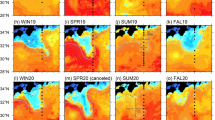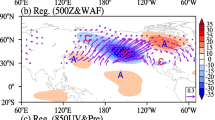Abstract
The standard deviation of the central Pacific sea surface temperature anomaly (SSTA) during the period from October to February shows that the central Pacific SSTA variation is primarily due to the occurrence of the Central Pacific El Niño (CP-El Niño) and has a connection with the subtropical air-sea interaction in the northeastern Pacific. After removing the influence of the Eastern Pacific El Niño, an S-EOF analysis is conducted and the leading mode shows a clear seasonal SSTA evolving from the subtropical northeastern Pacific to the tropical central Pacific with a quasi-biennial period. The initial subtropical SSTA is generated by the wind speed decrease and surface heat flux increase due to a north Pacific anomalous cyclone. Such subtropical SSTA can further influence the establishment of the SSTA in the tropical central Pacific via the wind-evaporation-SST (WES) feedback. After established, the central equatorial Pacific SSTA can be strengthened by the zonal advective feedback and thermocline feedback, and develop into CP-El Niño. However, as the thermocline feedback increases the SSTA cooling after the mature phase, the heat flux loss and the reversed zonal advective feedback can cause the phase transition of CP-El Niño. Along with the wind stress variability, the recharge (discharge) process occurs in the central (eastern) equatorial Pacific and such a process causes the phase consistency between the thermocline depth and SST anomalies, which presents a contrast to the original recharge/discharge theory.
Similar content being viewed by others
References
An, S. I., and Jin F. F., 2001. Collective role of zonal advective and thermocline feedbacks in ENSO mode. Journal of Climate, 14: 3421–3432.
Anderson, B. T., 2003. Tropical Pacific sea-surface temperatures and preceding sea level pressure anomalies in the subtropical North Pacific. Journal of Geophysical Research, 108, 4732, DOI: 10.1029/2003JD003805.
Anderson, B. T., 2004. Investigation of a large-scale mode of ocean-atmosphere variability and its relation to tropical Pacific sea surface temperature anomalies. Journal of Climate, 17: 4089–4098.
Ashok, K., Behera, S., Rao, A. S., Weng, H., and Yamagata, T., 2007. El Niño Modoki and its teleconnection. Journal of Geophysical Research, 112: C11007, DOI: 10.1029/2006JC003798.
Balmaseda, M. A., Vidard, A., and Anderson, D. L. T., 2008. The ECMWF ocean analysis system: ORA-S3. Monthly Weather Review, 136: 3018–3034.
Barnett, T. P., 1991. The interaction of multiple time scales in the tropical climate system. Journal of Climate, 4: 269–285.
Barnett, T. P., Pierce, D. W., Latif, M., Dommenget, D., and Saravana, R., 1999. Interdecadal interactions between the tropics and the midlatitudes in the Pacific basin. Geophysical Research Letters, 26: 615–618.
Battisti, D. S., 1988. Dynamics and thermodynamics of a warming event in a coupled tropical atmosphere-ocean model. Journal of Atmosphere Science, 45: 2889–2919.
Bejarano, L., and Jin, F. F., 2008. Coexistence of equatorial coupled modes of ENSO. Journal of Climate, 21: 3051–3067, DOI: 10.1175/2007JCLI1679.1.
Burgers, G., Jin, F. F., and Oldenborgh, G. J., 2005. The simplest ENSO recharge oscillator. Geophysical Research Letters, 32, L13706, DOI: 10.1029/2005GL022951.
Chang, P., Zhang, L., Saravanan, R., Vimont, D. J., Chiang, J. C. H., Ji, L., Seidel, H., and Tippett, M. K., 2007. Pacific meridional mode and El Niño-Southern Oscillation. Geophysical Research Letters, 34, L16608, DOI: 10.1029/2007GL030302.
Clarke, A. J., Gorder, V. S., and Colantuono, G., 2007. Wind stress curl and ENSO discharge/recharge in the Equatorial Pacific. Journal of Physical Oceanography, 37: 1077–1091, DOI: 10.1175/JPO3035.1.
Di Lorenzo, E., Cobb, K. M., Furtado, J. C., Schneider, N., Anderson, B. T., Bracco, A., Alexander, M. A., and Vimont, D. J., 2010. Central Pacific El Niño and decadal climate change in the North Pacific Ocean. Nature Geoscience, 3: 762–765, DOI: 10.1038/ngeo984.
Gill, A. E., 1980. Some simple solutions for heat induced tropical circulation. Quarterly Journal of the Royal Meteorological Society, 106: 447–462.
Gu, D., and Philander, S. G. H., 1995. Secular changes of annual and interannual variability in the tropics during the past century. Journal of Climate, 8: 864–876.
Harrison, D. E., 1987. Monthly mean island surface winds in the central tropical Pacific and El Niño. Monthly Weather Review, 115: 3133–3145.
Harrison, D. E., and Vecchi, G. A., 1999. On the termination of El Niño. Geophysical Research Letters, 26(11): 1593–1596, DOI: 10.1029/1999GL900316.
Horii, T., Ueki, I., and Hanawa, K., 2012. Breakdown of ENSO predictors in the 2000s: Decadal changes of recharge/ discharge-SST phase relation and atmospheric intraseasonal forcing. Geophysical Research Letters, 39, L10707, DOI: 10.1029/2012GL051740.
Jin, F. F., 1996. Tropical ocean-atmosphere interaction, the Pacific cold tongue, and the El Niño-Southern Oscillation. Science, 274: 76–78.
Jin, F. F., 1997a. An equatorial ocean recharge paradigm for ENSO. Part I: Conceptual model. Journal of Atmosphere Science, 54: 811–829.
Jin, F. F., 1997b. An equatorial ocean recharge paradigm for ENSO. Part II: A stripped-down coupled model. Journal of Atmosphere Science, 54: 830–847.
Jin, F. F, Kim, S. T., and Bejarano, L., 2006. A coupled-stability index for ENSO. Geophysical Research Letters, 33, L23708, DOI: 10.1029/2006GL027221.
Kalnay, E., Kanamitsu, M., Kistler, R., Collins, W., Deaven, D., Gandin, L., Iredell, M., Saha, S., White, G., Woollen, J., Zhu, Y., Leetmaa, A., Reynolds, B., Chelliah, M., Ebisuzaki, W., Higgins, W., Janowiak, J., Mo, K. C., Ropelewski, C., Wang, J., Jenne, R., and Joseph, D., 1996. The NCEP/NCAR 40-year reanalysis project. Bulletin of the American Meteorological Society, 77: 437–472, DOI: 10.1175/1520-0477 (1996) 077<0437:TNYRP>2.0.CO;2.
Kang, I. S., An, S. I., and Jin, F. F., 2001. A systematic approximation of the SST anomaly equation for ENSO. Journal of Meteorology Society of Japan, 79: 1–10.
Kang, I. S., Kug, J. S., An, S. I., and Jin, F. F., 2004. A near annual Pacific Basin mode. Journal of Climate, 17(12): 2478–2488.
Kao, H. Y., and Yu, J. Y., 2009. Contrasting eastern-Pacific and central Pacific types of El Niño. Journal of Climate, 22: 615–632, DOI: 10.1175/2008JCLI2309.1.
Karspeck, A. R., and Cane, M. A., 2002. Tropical Pacific 1976–77 climate shift in a linear, wind-driven model. Journal of Physical Oceanography, 32(8): 2350–2360.
Kleeman, R., McCreary, J., and Klinger, B. A., 1999. A mechanism for generating ENSO decadal variability. Geophysical Research Letters, 26(12): 1743–1746, DOI: 10.1029/1999GL900352.
Kug, J. S., Choi, J., An, S. I., Jin, F. F., and Wittenberg, A. T., 2010. Warm pool and cold tongue El Niño events as simulated by the GFDL 2.1 coupled GCM. Journal of Climate, 23: 1226–1239, DOI: 10.1175/2010JCLI3688.1.
Kug, J. S., Jin, F. F., and An, S. I., 2009. Two types of El Niño events: Cold tongue El Niño and warm pool El Niño. Journal of Climate, 22: 1499–1515, DOI: 10.1175/2008JCLI2624.1.
Kug, J. S., Kang, I. S., and An, S. I., 2003. Symmetric and antisymmetric mass exchanges between the equatorial and off-equatorial Pacific associated with ENSO. Journal of Geophysical Research, 108: 3284, DOI: 10.1029/2002JC001671.
Larkin, N. K., and Harrison, D. E., 2005. Global seasonal temperature and precipitation anomaly during El Niño autumn and winter. Geophysical Research Letters, 32, L16705, DOI: 10.1029/2005GL022860.
Lau, N. C., Philander, S. G. H., and Nath, M. J., 1992. Simulation of ENSO-like phenomena with a low-resolution coupled GCM of the global ocean and atmosphere. Journal of Climate, 5: 284–307.
Lee, T., and McPhaden, M. J., 2010. Increasing intensity of El Niño in the central-equatorial Pacific. Geophysical Research Letters, 37, L14603, DOI: 10.1029/2010GL044007.
Liu, Q. Y., Liu, Z. Y., and Pan, A. J., 2006. Conceptual model about the interaction between El Niño/Southern Oscillation and Quasi-Biennial Oscillation in far west equatorial Pacific. Science in China: Series D, Earth Sciences, 49(8): 889–896.
Liu, Z., and Alexander, M., 2007. Atmospheric bridge, oceanic tunnel, and global climatic teleconnections. Reviews of Geophysics, 45, RG2005, DOI: 10.1029/2005RG000172.
McPhaden, M., and Zhang, D., 2002. Slowdown of the meridional overturning circulation in the upper Pacific Ocean. Nature, 415: 603–608.
Meinen, C. S., and McPhaden, M. J., 2000. Observations of warm water volume changes in the Equatorial Pacific and their relationship to El Niño and La Niña. Journal of Climate, 13: 3551–3559.
Merryfield, W., and Boer, G., 2005. Variability of upper Pacific Ocean overturning in a coupled climate model. Journal of Climate, 18: 666–683.
Nonaka, M., Xie, S. P., and McCreary, J., 2002. Decadal variations in the subtropical cells and equatorial Pacific SST. Geophysical Research Letters, 29, 1116, DOI: 10.1029/2001GL 013717.
Pierce, D. W., Barnett, T. P., and Latif, M., 2000. Connections between the Pacific Ocean Tropics and midlatitudes on decadal timescales. Journal of Climate, 13: 1173–1194.
Rasmusson, E. M., and Carpenter, T. H., 1982. Variations in tropical sea surface temperature and surface wind field associated with the Southern Oscillation/El Niño. Monthly Weather Review, 110: 354–384.
Rayner, N. A., Parker, D. E., Horton, E. B., Folland, C. K., Alexander, L. V., Rowell, D. P., Kent, E. C., and Kaplan, A., 2003. Global analyses of sea surface temperature, sea ice, and night marine air temperature since the late nineteenth century. Journal of Geophysical Research, 108, 4407, DOI: 10.1029/2002JD002670.
Ren, H. L., and Jin, F. F., 2011. Niño indices for two types of ENSO. Geophyical Research Letters, 38, L04704, DOI: 10.1029/2010GL046031.
Vimont, D. J., Alexander, M., and Fontaine, A., 2009. Midlatitude excitation of tropical variability in the Pacific: The role of thermodynamic coupling and seasonality. Journal of Climate, 22(3): 518–534, DOI: 10.1175/2008JCLI2220.1.
Vimont, D. J., Battisti, D. S., and Hirst, A. C., 2001. Footprinting: A seasonal connection between the tropics and mid-latitudes. Geophysical Research Letters, 28(20): 3923–3926, DOI: 10.1029/2001GL013435.
Vimont, D. J., Wallace, J. M., and Battisti, D. S., 2003. The seasonal footprinting mechanism in the Pacific: Implications for ENSO. Journal of Climate, 16: 2668–2675.
Wang, B., and An, S. I., 2005. A method for detecting season-dependent modes of climate variability: S-EOF analysis. Geophysical Research Letters, 32, L15710, DOI: 10.1029/2005GL022709.
Wang, C., and Picaut, J., 2004. Understanding ENSO physics — A review. In: Earth’s Climate: The Ocean-Atmosphere Interaction. Wang, C. et al., eds., AGU Geophysical Monograph Series, 147: 21–48.
Xie, S. P., and Philander, S. G. H., 1994. A coupled ocean-atmosphere model of relevance to the ITCZ in the eastern Pacific. Tellus, 46: 340–350, DOI: 10.1034/j.1600-0870.1994.t01-1-00001.x.
Yeh, S. W., Kug, J. S., Dewitte, B., Kwon, M. H., Kirtman, B., and Jin, F. F., 2009. El Niño in a changing climate. Nature, 461: 511–514, DOI: 10.1038/nature08316.
Yu, J. Y., and Kim, S. T., 2011. Relationships between extratropical sea level pressure variations and the Central Pacific and Eastern Pacific types of ENSO. Journal of Climate, 24: 708–720, DOI: 10.1175/2010JCLI3688.1.
Yu, J. Y., Kao, H. Y., and Lee, T., 2010. Subtropics-related interannual sea surface temperature variability in the central equatorial Pacific. Journal of Climate, 23: 2869–2884.
Author information
Authors and Affiliations
Corresponding author
Rights and permissions
About this article
Cite this article
Xie, R., Huang, F. & Ren, H. Subtropical air-sea interaction and development of central Pacific El Niño. J. Ocean Univ. China 12, 260–271 (2013). https://doi.org/10.1007/s11802-013-2143-7
Received:
Revised:
Accepted:
Published:
Issue Date:
DOI: https://doi.org/10.1007/s11802-013-2143-7




